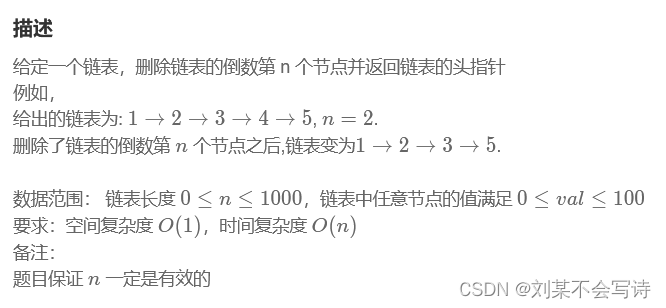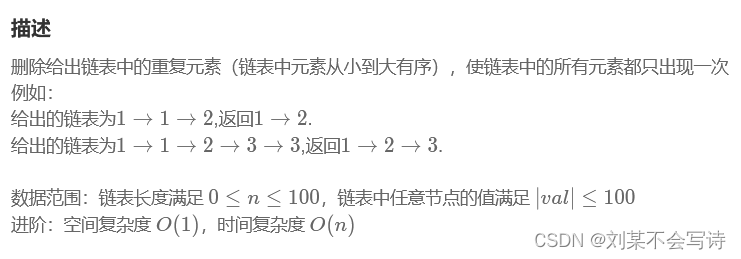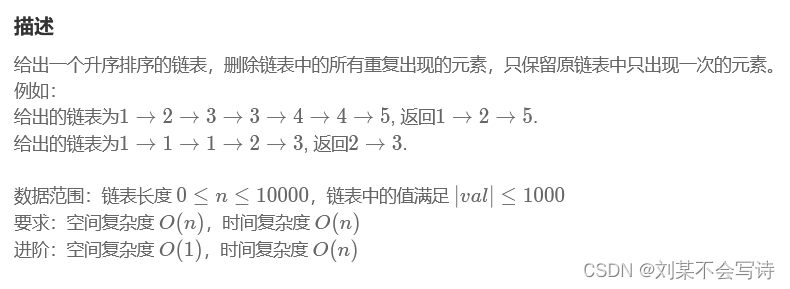1.删除链表的倒数第n个节点
 这题我采用的是先遍历得到总长度,然后根据总长度来进行遍历到倒数第n个节点。
这题我采用的是先遍历得到总长度,然后根据总长度来进行遍历到倒数第n个节点。
class Solution {
public:
ListNode* removeNthFromEnd(ListNode* head, int n) {
int i = 0;
ListNode* tmp = new ListNode(-1);
tmp->next = head;
ListNode* mid = tmp;
while (head->next) {
head = head->next;
i++;
}
for (int j = 0; j < i - n + 1; j++) {
tmp = tmp->next;
}
tmp->next = tmp->next->next;
return mid->next;
}
};
2.两个链表的第一个公共节点
 这题开始我就开始使用一个很有意思的容器了,set容器,它有一个特性,不允许元素重复,所以只要将一个压入set,再尝试压另一个,它就会出现count为1,即为第一个公共结点。
这题开始我就开始使用一个很有意思的容器了,set容器,它有一个特性,不允许元素重复,所以只要将一个压入set,再尝试压另一个,它就会出现count为1,即为第一个公共结点。
class Solution {
public:
ListNode* FindFirstCommonNode( ListNode* pHead1, ListNode* pHead2) {
set<ListNode*> s;
while(pHead1){
s.insert(pHead1);
pHead1=pHead1->next;
}
while(pHead2){
if(s.count(pHead2)==true){
break;
}
pHead2=pHead2->next;
}
return pHead2;
}
};
3.链表相加
 这道题目花了我比较久的时间,我采用的是使用三个栈的方式,将要相加的链表压入两个栈,然后结果压入第三个栈。
这道题目花了我比较久的时间,我采用的是使用三个栈的方式,将要相加的链表压入两个栈,然后结果压入第三个栈。
#include <numeric>
class Solution {
public:
ListNode* addInList(ListNode* head1, ListNode* head2) {
// write code here
stack<int> s1;
stack<int> s2;
stack<int> s3;
ListNode* head3 = new ListNode(0);
ListNode* ac = head3;
int tmp=0;
while(head1){
s1.push(head1->val);
head1=head1->next;
}
while(head2){
s2.push(head2->val);
head2=head2->next;
}
while(!s1.empty()&&!s2.empty()){
s3.push((s1.top()+s2.top()+tmp)%10);
tmp=(s1.top()+s2.top()+tmp)/10;
s1.pop();
s2.pop();
}
while(!s1.empty()) {
s3.push((s1.top()+tmp)%10);
tmp=(s1.top()+tmp)/10;
s1.pop();
}
while(!s2.empty()) {
s3.push((s2.top()+tmp)%10);
tmp=(s2.top()+tmp)/10;
s2.pop();
}
s3.push(tmp);
if(s3.top()==0) s3.pop();
while(!s3.empty()){
ListNode* node = new ListNode(1);
head3->next = node;
node->val=s3.top();
s3.pop();
head3 = head3->next;
}
return ac->next;
}
};
4.单链表的排序
 这题偷了一下懒,使用了C++自带的sort函数,但是sort之后要记得再反转一下链表。
这题偷了一下懒,使用了C++自带的sort函数,但是sort之后要记得再反转一下链表。
class Solution {
public:
ListNode* sortInList(ListNode* head) {
vector<int>tmp;
int i = 0;
while (head) {
tmp.push_back(head->val);
head = head->next;
i++;
}
sort(tmp.begin(), tmp.end());
ListNode* out = new ListNode(0);
ListNode* t = out;
for (int j = 0; j < i; j++) {
ListNode* node = new ListNode(0);
node->val = tmp.back();
tmp.pop_back();
out->next = node;
out = out->next;
}
ListNode* newhead = nullptr;
while (t->next) {
ListNode* temp = t->next->next;
t->next->next = newhead;
newhead = t->next;
t->next = temp;
}
return newhead;
}
};
5.判断一个链表是否为回文结构
 很粗暴,压进数组,直接遍历一半,和后面一半对比即可。
很粗暴,压进数组,直接遍历一半,和后面一半对比即可。
class Solution {
public:
bool isPail(ListNode* head) {
int tmp[100000],i=0;
while(head){
tmp[i]=head->val;
head=head->next;
i++;
}
if(i==1) return true;
for(int j=0;j<=i/2;j++){
if(tmp[j]!=tmp[i-j-1]){
return false;
}
}
return true;
}
};
6.链表的奇偶重排
 奇数节点压进一个队列,偶数节点压进一个队列,然后在压出就可以了。
奇数节点压进一个队列,偶数节点压进一个队列,然后在压出就可以了。
class Solution {
public:
ListNode* oddEvenList(ListNode* head) {
queue<int> q1;
queue<int> q2;
int tmp = 1;
while (head) {
if (tmp % 2 == 0) {
q2.push(head->val);
} else {
q1.push(head->val);
}
tmp++;
head = head->next;
}
ListNode* sum = new ListNode(0);
ListNode* out = sum;
while (!q1.empty()) {
ListNode* node = new ListNode(0);
node->val = q1.front();
q1.pop();
sum->next = node;
sum = node;
}
while (!q2.empty()) {
ListNode* node = new ListNode(0);
node->val = q2.front();
q2.pop();
sum->next = node;
sum = node;
}
return out->next;
}
};
7.删除有序链表中重复的元素-1
 简简单单一个set,就是这个set的遍历一般可能有点陌生。
简简单单一个set,就是这个set的遍历一般可能有点陌生。
#include<set>
class Solution {
public:
ListNode* deleteDuplicates(ListNode* head) {
// write code here
set<int> s;
while(head){
s.insert(head->val);
head = head->next;
}
ListNode* out = new ListNode(0);
ListNode* ac = out;
for(auto item:s){
ListNode* temp = new ListNode(item);
out->next = temp;
out = temp;
}
return ac->next;
}
};
8.删除有序链表中重复的元素-2
 这题用set和vector,有重复就用vector记录下来,最后用erase一起删,就可以保证删除干净了。
这题用set和vector,有重复就用vector记录下来,最后用erase一起删,就可以保证删除干净了。
class Solution {
public:
#include<set>
#include<vector>
ListNode* deleteDuplicates(ListNode* head) {
set<int> s;
vector<int> v;
while(head){
if(s.count(head->val)==1){
v.push_back(head->val);
}
s.insert(head->val);
head = head->next;
}
while(!v.empty()){
s.erase(v.back());
v.pop_back();
}
ListNode* out = new ListNode(0);
ListNode* ac = out;
for(auto item:s){
ListNode* temp = new ListNode(item);
out->next = temp;
out = temp;
}
return ac->next;
}
};
谢谢阅读!




















 493
493











 被折叠的 条评论
为什么被折叠?
被折叠的 条评论
为什么被折叠?








